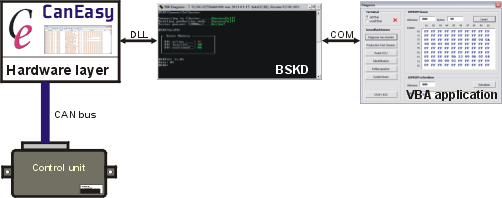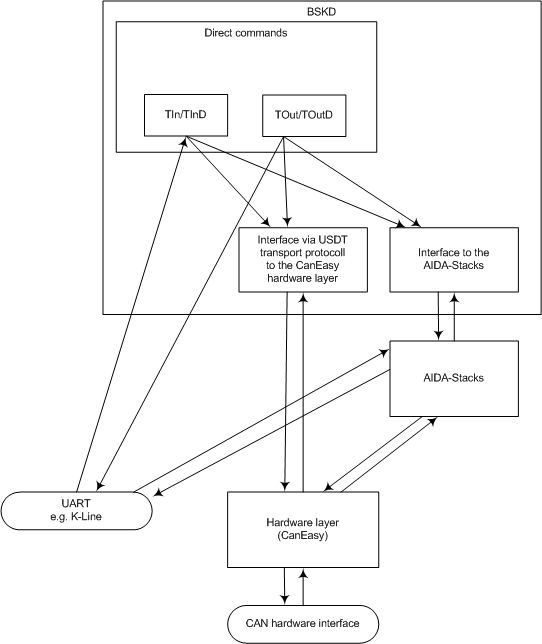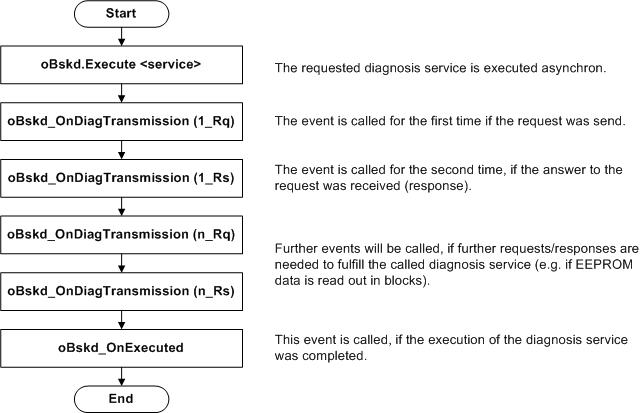With the implementation of the BSKD7 in CanEasy also a corresponding COM interface was added, to handle the BSKD7 via VBA or an external software components (C#, VB.Net,...).
BSKD7 projects can be managed and executed via the COM interface. Furthermore it is possible to execute commands and macros and read-out buffers (like TInD or TOutD) or return values. The command or macro execution can occur synchronous or asynchronous (event triggered). So diagnostic functions can be realized e.g. through the integrated VBA development environment. The terminal window of the BSKD7 can be suppressed via the COM interface, so the controlling of the whole diagnostics services can be realized with e.g. a VBA application.

Diagnostic communication with a control unit via a VBA application.
If the BSK terminal window is not needed, it can be suppressed.
The interface to the BSKD7 is available via the BSKDApp object. To use this object a reference to the type library "BSKD 1.0 Typbibliothek" (BSKDTerminal.plu) is needed. After the installation of CanEasy the reference is already set.
Amongst other things, it is also possible to test the diagnostics communication with BSKD7. The whole diagnostics communication works with the global read-out buffers TIn/TInD and Tout/TOutD. With these buffer around 1kB payload can be assimilated. The following graphic shows the possible lines of communication and the usage of the buffers.

TIn and TOut consist of the following parts:
•Length of the telegrams (16 bit, low byte, high byte).
•Telegram header
•Telegram data (control byte respectively service identifier and corresponding data/parameters)
•Checksum
The are synonyms für the access to the telegram data (TInD/TOutD), because the header is only used for testing the diagnostics communication, but not for the normal usage of the diagnostics.
|
Exaple: ID 0xFF on serial BSK diagnostics 7:
Request:
Telegram length |
ECU address |
Length |
Control byte |
Data |
Checksum |
05 00 |
AB |
05 |
49 |
FF |
18 |
Response:
Telegram length |
ECU address |
Length |
Control byte |
Data |
Checksum |
08 00 |
AB |
08 |
49 |
12 34 56 78 |
E2 |
In this case the header consists of two bytes, ecu address and length and TInD[0] and TOutD[0] which are containing the control byte (="KB" or "SI" for "service identifier"; Address of TInD[0] = address of TIn[4]). For the access to the first data byte after the control byte via TIn/TOut instead of TInD/TOutD the symbol TD1Pos can be used, which has the value 5 in this case (address of TInD[1] = address of TIn[TD1Pos]). Transmitted are in this case exact this five bytes: 0xAB, 0x05, 0x49, 0xFF, 0x18
Example for the usage of the buffers via COM interface
These buffers are available via the COM interface. The following VBA example show e.g. how to read data out of buffer TInD after execution of a diagnostics command:
Private Sub FirstBSKDMacro()
'Define object for BSKD7 Dim oBskd As BSKDApp 'Return value of synchron execution Dim oBSKDResult As BSKDExecutionResult 'Define variable for buffer content Dim vDaten as Variant 'Constant for diagnostics timeout
'Create new diagnostics object Set oBskd = New BSKDApp 'Execute command synchronous (read five bytes from EEPROM address 123h on) Set oBSKDResult = oBskd.ExecuteAndWait("kr $123,,5", cTimeoutDiagAnswer) 'read TInD buffer data into variable vDaten = oBSKDResult.TInD
End Sub |
On synchronous execution the VBA macro is waiting until the BSKD7 command execution has ended or the defined timeout (in milliseconds) is exceeded. Afterwards the data can be read out of the buffers (like done in the example) of are available via the return value BSKDExecutionResult of ExecuteAndWait.
The buffer data can also be obtained event-driven. For this the user has register this event with oBSKD.ExecutedEvents = True. If a BSKD7 command or macro is now executed with the method oBSKD.Execute, the VBA macro execution continues directly. The event oBSKD_OnExecuted is raised immediately after the execution of the BSKD7 command or macro has finished. As parameter of the event the buffers are available as BSKDExecutionResult.
'Define object for BSKD7 (with events) Public WithEvents oBskd As BSKDApp
'function for asynchronous execution of a diagnostics command Private Sub SecondBSKDMakro()
'Create new diagnostics object Set oBskd = New BSKDApp 'Execute command asynchronous (read five bytes from EEPROM address 123h on) oBskd.Execute "kr $123,,5"
End Sub
'This function is being executed as event after execution of the diagnostics command Private Sub oBskd_OnExecuted(ByVal arg As CanEasyBSKD.BSKDExecutionResult)
'Define variable for buffer Dim vDaten as Variant
'Read data from buffer
End Sub
|
|
VBA events of BSKD7
If the asynchronous command execution is used, the following events are available:
•OnDiagTransmission (ByVal arg As CanEasyBSKD.BSKDDiagTransmissionResult)
This event is called on every diagnostics request and response.
•OnExecuted (ByVal arg As CanEasyBSKD.BSKDExecutionResult)
This event is called if the execution of a diagnostics command or macro is completely fulfilled and the terminal is ready for a new input.
Both events can be enabled independent of each other via the following properties:
•TransmissionEvents = True
•ExecutedEvents = True
The named events will also be called (if they are active), if a command was entered directly in the terminal window. The event OnExecuted contains the property arg.IsOwnCommand which can be used to differ between the events. So it can be decided, if the event happens in case of a own VBA execution or another execution like e.g. the direct execution of a command in the terminal window.
Both events have corresponding results as structure in a parameter available (like TInD/TOutD and state of the execution).
If both events are set to active, the are called in the following order in case of an execution of a diagnostics service or macro:
